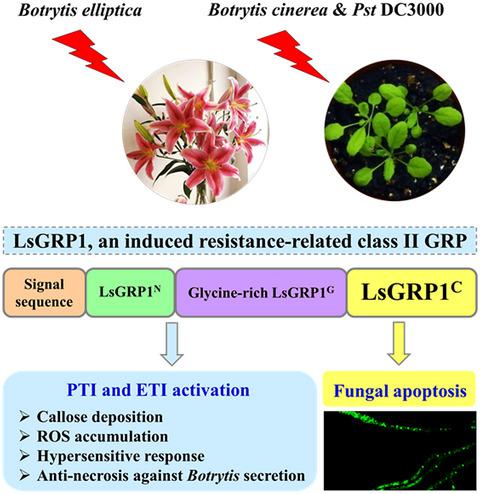当前位置:
X-MOL 学术
›
Mol. Plant Pathol.
›
论文详情
Our official English website, www.x-mol.net, welcomes your
feedback! (Note: you will need to create a separate account there.)
LsGRP1, a class II glycine-rich protein of Lilium, confers plant resistance via mediating innate immune activation and inducing fungal programmed cell death.
Molecular Plant Pathology ( IF 4.8 ) Pub Date : 2020-07-14 , DOI: 10.1111/mpp.12968 Chia-Hua Lin,Ying-Chieh Pan,Nai-Hua Ye,Yu-Ting Shih,Fan-Wei Liu,Chao-Ying Chen
Molecular Plant Pathology ( IF 4.8 ) Pub Date : 2020-07-14 , DOI: 10.1111/mpp.12968 Chia-Hua Lin,Ying-Chieh Pan,Nai-Hua Ye,Yu-Ting Shih,Fan-Wei Liu,Chao-Ying Chen

|
Defence‐related LsGRP1 is a leaf‐specific plant class II glycine‐rich protein (GRP) involved in salicylic acid‐induced systemic resistance against grey mould caused by necrotrophic Botrytis elliptica in lily (Lilium) cultivar Stargazer. The C‐terminal region of LsGRP1 (LsGRP1C) can inhibit fungal growth in vitro via a mechanism of inducing fungal apoptosis programmed cell death (PCD). In this study, the role of LsGRP1 in induced defence mechanism was investigated using LsGRP1‐silenced Stargazer lily and LsGRP1‐transgenic Arabidopsis thaliana. LsGRP1 silencing in lily was found to slightly inhibit plant growth and greatly increase the susceptibility to B. elliptica by suppressing callose deposition and early reactive oxygen species (ROS) accumulation. In contrast, LsGRP1‐transgenic Arabidopsis showed higher resistance to Botrytis cinerea and also to Pseudomonas syringae pv. tomato DC3000 as compared to the wild type, accompanied with the enhancement of callose deposition and ROS accumulation. Additionally, LsGRP1 silencing increased plant cell death caused by B. elliptica secretion and reduced pathogen‐associated molecular pattern (PAMP)‐triggered defence activation in Stargazer lily. Consistently, LsGRP1 expression boosted PAMP‐triggered defence responses and effector recognition‐induced hypersensitive response in Arabidopsis. Moreover, fungal apoptosis PCD triggered by LsGRP1 in an LsGRP1C‐dependent manner was demonstrated by leaf infiltration with LsGRP1C‐containing recombinant proteins in Stargazer lily. Based on these results, we presume that LsGRP1 plays roles in plant defence via functioning as a pathogen‐inducible switch for plant innate immune activation and acting as a fungal apoptosis PCD inducer to combat pathogen attack.
中文翻译:

LsGRP1是百合属II类富含甘氨酸的蛋白质,可通过介导先天免疫激活和诱导真菌程序性细胞死亡来赋予植物抗性。
防御相关的LsGRP1是一种叶特异的植物II类富含甘氨酸的蛋白(GRP),参与水杨酸诱导的对百合(Lilium)栽培品种Stargazer的坏死性葡萄孢的灰霉病引起的系统对灰霉病的系统抗性。LsGRP1的C末端区域(LsGRP1 C)可通过诱导真菌凋亡程序性细胞死亡(PCD)的机制在体外抑制真菌生长。在这项研究中,使用LsGRP1沉默的Stargazer百合和LsGRP1转基因拟南芥研究了LsGRP1在诱导防御机制中的作用。发现百合中的LsGRP1沉默可略微抑制植物生长并大大增加对玉米的敏感性椭圆芽孢杆菌通过抑制reactive的沉积和早期活性氧(ROS)的积累。相反,LsGRP1转基因拟南芥对灰葡萄孢和丁香假单胞菌pv表现出较高的抗性。番茄DC3000与野生型相比,伴随着愈伤组织沉积和ROS积累的增强。此外,LsGRP1沉默增加了由椭圆芽孢杆菌分泌引起的植物细胞死亡,并降低了观星百合中病原体相关分子模式(PAMP)触发的防御激活。一致地,LsGRP1拟南芥中的表达增强了PAMP触发的防御反应和效应子识别诱导的超敏反应。此外,通过在Stargazer百合中用含LsGRP1 C的重组蛋白浸润叶片,证明了LsGRP1以LsGRP1 C依赖性方式触发的真菌凋亡PCD 。根据这些结果,我们推测LsGRP1通过充当植物固有免疫激活的病原体诱导开关以及充当抵抗病原体侵害的真菌凋亡PCD诱导物而在植物防御中发挥作用。
更新日期:2020-07-14
中文翻译:

LsGRP1是百合属II类富含甘氨酸的蛋白质,可通过介导先天免疫激活和诱导真菌程序性细胞死亡来赋予植物抗性。
防御相关的LsGRP1是一种叶特异的植物II类富含甘氨酸的蛋白(GRP),参与水杨酸诱导的对百合(Lilium)栽培品种Stargazer的坏死性葡萄孢的灰霉病引起的系统对灰霉病的系统抗性。LsGRP1的C末端区域(LsGRP1 C)可通过诱导真菌凋亡程序性细胞死亡(PCD)的机制在体外抑制真菌生长。在这项研究中,使用LsGRP1沉默的Stargazer百合和LsGRP1转基因拟南芥研究了LsGRP1在诱导防御机制中的作用。发现百合中的LsGRP1沉默可略微抑制植物生长并大大增加对玉米的敏感性椭圆芽孢杆菌通过抑制reactive的沉积和早期活性氧(ROS)的积累。相反,LsGRP1转基因拟南芥对灰葡萄孢和丁香假单胞菌pv表现出较高的抗性。番茄DC3000与野生型相比,伴随着愈伤组织沉积和ROS积累的增强。此外,LsGRP1沉默增加了由椭圆芽孢杆菌分泌引起的植物细胞死亡,并降低了观星百合中病原体相关分子模式(PAMP)触发的防御激活。一致地,LsGRP1拟南芥中的表达增强了PAMP触发的防御反应和效应子识别诱导的超敏反应。此外,通过在Stargazer百合中用含LsGRP1 C的重组蛋白浸润叶片,证明了LsGRP1以LsGRP1 C依赖性方式触发的真菌凋亡PCD 。根据这些结果,我们推测LsGRP1通过充当植物固有免疫激活的病原体诱导开关以及充当抵抗病原体侵害的真菌凋亡PCD诱导物而在植物防御中发挥作用。











































 京公网安备 11010802027423号
京公网安备 11010802027423号